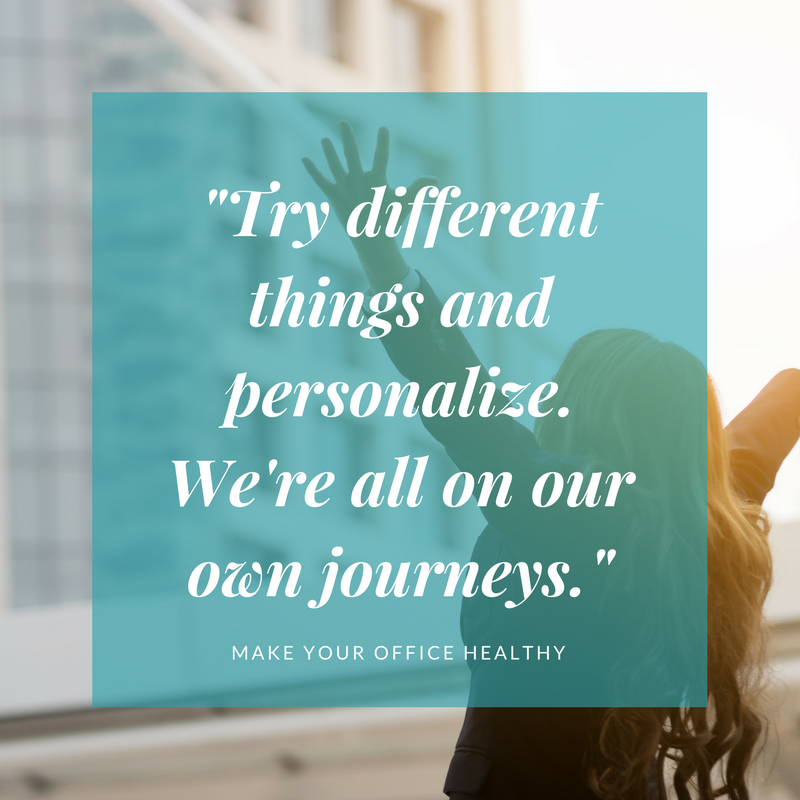Carebook’s nutritionist and wellness expert shares how to help kick-start a healthy team challenge.
Workplace challenges can:
- Raise awareness around specific health and wellness practices
- Provide education and knowledge that wouldn’t otherwise be addressed
- Foster social support and competition and collaboration—both are important behavior change techniques that can increase participation
- Cultivate a healthier team culture by increasing morale and relationships
The Carebook team recently did a group challenge and gave up added sugar for 30 days. It started from one team member’s personal challenge, but it sparked a greater interest, so we tried it together. We learned a lot along the way, and you can read some insights here. Since we’re lucky enough to have a nutritionist with experience in workplace wellness on our team, we wanted to share so other organizations could set up similar challenges.
Josée Thibodeau has focused her career on delivering health and wellness solutions. Before Carebook, she worked for the Canadian Medical Association to manage health portals which helped individuals manage health, physicians engage patients, and employers address health risks in their organizations.
BUILDING A FOUNDATION
Josée says both abstract ideas like “trust, positive attitudes, and having champions in the office” and concrete things like “communication spaces or physical infrastructure like bike racks” can help play a part in making a workplace health and wellness challenge successful. She suggests a few things are important to start building a foundation that can support challenges and change.
Understand the interests and needs of employees. A health risk assessment and survey about employees’ interest will not only provide the baseline to evaluate progress but will also allow employees to voice their desires when it comes to workplace health.
Facilitate the experience. Think about the experience from your employees’ point of view and understand they want to know you value them enough to invest in them. Providing space, equipment or even fun give-aways in relation to the chosen topic may help send that message. It might just be a bottle of water, a healthy snack, an app to track activity, or a dedicated meditation room, but be sure to show that you are willing to invest in them as individuals by being thoughtful is a great first step to getting people to invest in themselves.
Encourage and lead by example. Get your CEO to (Truly! Sincerely!) embrace the initiative. Find the natural champions in every team or location to boost participation and use their energy to help propel the initiative.
Open-up the communication lines—both ways! Your intranet, slack channel or any other means to communicate and share will have a greater impact. Be willing to really listen to feedback, and to make improvements along the way if necessary.
Have a leaderboard or another tool to track the progress and success of the participants. It’s fun to encourage collaboration for those who want encouragement, and also provide a means for (friendly) competition for those who respond to that. But remember to honor anonymity if that’s what people want.
STEP BY STEP
Your specific challenge might require more things than the list below, but if you’re planning something for your team, here are some things to think about to kick it off:
- Find a topic that matters to your employees
- Find your natural champions and ask them to help you cheerlead
- Gather information to share
- Open up a channel for encouragements & exchanges. Make it a safe place to share tips, recipes, struggles, jokes, etc.
- Launch it with a few bells and whistles
- Do regular touch points, challenge breaks where people can share willingly.
- Celebrate both relapse and success.
- Follow-up to see how people are doing after the challenge—consider building on it, or continuing it
INDIVIDUAL GAINS
Challenges are great ways to raise awareness and motivate, but we know that if too strict or not well adapted to people’s lifestyles they’re less likely to result in long-term changes.

“While team competition could be motivational for some, we know that’s not the case for everyone. You may have to try different things, or personalize challenges. It’s important not to give up, but to learn from every positive step you make. One of our core values at Carebook is to respect individuals on their own journey to better health, and to celebrate each individual to start wherever they are and move towards adopting healthier habits for life. For our first experiment, we adapted the popular sugar detox challenges, but we made the rules more flexible and personalized. Our common objective was to decrease sugar intake, but everyone had a chance to set their own realistic goals, increasing the chances that these new habits would stick beyond the end of the month. Some people went back to their old habits when the challenge was over. But some changed the way they eat—and four months later, they’re still going strong!”
Josée was impressed by how the challenge of individuals permeated into the family. “What started as a personal experience of one of our colleagues inspired our team, and our families, too. We heard how some of the Carebook team’s kids and teens starting checking their food labels. They were shocked to learn how much sugar they were drinking in their sport drinks and in unsuspecting places like ketchup, etc.”
The bottom line? By setting up small, team challenges, you’re setting up a greater opportunity for people to consider, explore, and take control of their health and wellness. And you might even be paving the way for lasting impact for employees, their overall health and well-being, and the health and well-being of their families, too.
If you’re part of a future-thinking organization and want to join the movement of better health for everyone, please contact us at Carebook.


